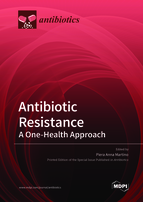Antibiotic Resistance: A One-Health Approach
A special issue of Antibiotics (ISSN 2079-6382).
Deadline for manuscript submissions: closed (31 March 2022) | Viewed by 41697
Special Issue Editor
Interests: antibiotic resistance; one health; bacterial infections; alternative to antibiotics; laboratory animals; infectious diseases
Special Issues, Collections and Topics in MDPI journals
Special Issue Information
Dear Colleagues,
Antimicrobial resistance and emergent multi-drug resistance are multifaceted and critical problems, considered one of the most urgent global challenges that must be solved. The use of antibiotics forces selective pressure on pathogens and also on commensal microorganisms, favoring the emergence of resistant strains. For years, farms and intensive breeding systems, together with the increasing spread of food-borne diseases, were seen as unique sources of this global problem. The One Health concept implicates a focus on issues at the human, animal (both domestic and wildlife), and environmental levels. This concept is not old and highlights the connection between human, animal, and environmental health in a rapidly changing world. Human and veterinary medicine must work together to control antimicrobial resistance. The One Health approach offers a crucial part of the solution. The development of new antibiotics is known to be time-consuming, but new alternative therapies are ongoing among the scientific community and are new promising protagonists in this panorama. “Full-length genome sequencing” and the molecular revolution based on high-throughput platforms will describe new molecular targets, as candidates for more precise pharmacological therapies, providing in-depth knowledge about pivotal bacterial molecular pathways.
This Special Issue encourages manuscript submissions that promote our understanding of antimicrobial resistance in both human and veterinary medicine, in a harmonized One Health approach; the description of antimicrobial resistance profile and the development of novel therapies are highly motivated.
Dr. Piera Anna Martino
Guest Editor
Manuscript Submission Information
Manuscripts should be submitted online at www.mdpi.com by registering and logging in to this website. Once you are registered, click here to go to the submission form. Manuscripts can be submitted until the deadline. All submissions that pass pre-check are peer-reviewed. Accepted papers will be published continuously in the journal (as soon as accepted) and will be listed together on the special issue website. Research articles, review articles as well as short communications are invited. For planned papers, a title and short abstract (about 100 words) can be sent to the Editorial Office for announcement on this website.
Submitted manuscripts should not have been published previously, nor be under consideration for publication elsewhere (except conference proceedings papers). All manuscripts are thoroughly refereed through a single-blind peer-review process. A guide for authors and other relevant information for submission of manuscripts is available on the Instructions for Authors page. Antibiotics is an international peer-reviewed open access monthly journal published by MDPI.
Please visit the Instructions for Authors page before submitting a manuscript. The Article Processing Charge (APC) for publication in this open access journal is 2900 CHF (Swiss Francs). Submitted papers should be well formatted and use good English. Authors may use MDPI's English editing service prior to publication or during author revisions.
Keywords
- Antibiotic-resistance
- One Health
- virulence factors
- Genomics
- Novel natural molecules
- Antimicrobial stewardship
Related Special Issue
- Antibiotic Resistance: A One-Health Approach, 2nd Edition in Antibiotics (2 articles)







